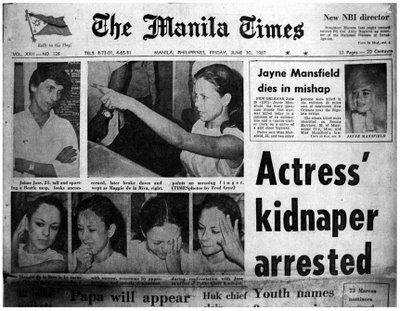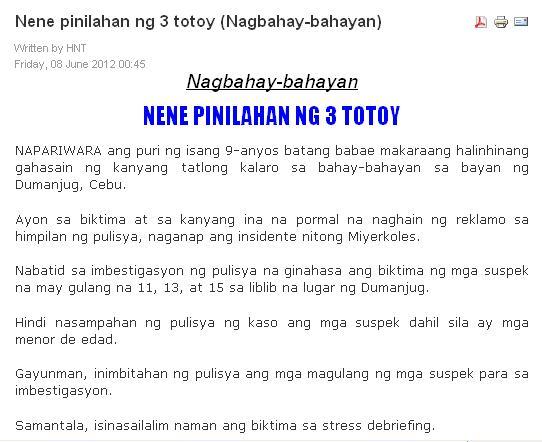Hataw Tabloid’s coverage of child rape
Sensationalized and porn-inspired?
“Sex sells” is already a cliché, but Metro Manila-based tabloids are still buying it. This reality is very evident in the way tabloids like Hataw are covering cases of rape involving children. The graphic language used in the narration of the said heinous crime is an ethical dilemma because it violates existing journalistic standards in the Philippines and overseas. In many ways, the reportage on child rape even borders on pornography.
Magnifying the problem is the fact that local tabloids enjoy wide circulation. According to the Asian Media Barometer 2011, tabloids can have circulations of as high as 500,000 each day. As Floyd Whaley of New York Times reported in an article last June, these tabloids far outsell broadsheets. Tabloids are also readily available to anyone, which means that even children can possibly read these rape news stories that use inappropriate language.
All persons below 18 years old are considered as children, according Republic Act 7610 or the Special Protection of Children against Child Abuse, Exploitation and Discrimination Act. The law also added that even those over this age can also be considered as such if they “are unable to fully take care of themselves or protect themselves from abuse, neglect, cruelty, exploitation or discrimination because of a physical or mental disability or condition.” Rape carries the maximum penalty of reclusion perpetua or imprisonment of at least 30 years.
Despite the harsh punishment, rape remains prevalent. Citing figures from Philippine National Police’s Women and Children Protection Center, the Center for Women’s Resources has reported early this year that one child is raped every 2 hours and 30 minutes. This explains why tabloids never fail to carry at least one rape story every day. Rape stories have human interest as its main news value, except on rare instances when the victim is a public figure even before the crime (e.g. Maggie dela Riva during the 1960s).

Hataw tabloid seems to have made it a point to present their rape stories in the most salacious manner possible. Some of its headlines are the following:
- 3-anyos nene hinalay ng kompadre ni tatay – January 6, 2012
- 2 menor na anak, nilantakan ng manyak – January 27, 2012
- 9-anyos, ginahasa ng sinulsulan ng demonyo – February 12, 2012
- 3-anyos na ampon, dinonselya ni lolo – April 13, 2012
- 12-anyos biyak sa padyak – June 1, 2012
- Nene, pinilahan ng tatlong totoy – June 8, 2012
- 13-anyos ‘inotso-otso’ ni lolo, dinugo – August 13, 2012
- 14-anyos biniyak ng stepdad (Huli sa akto ni nanay) – September 12, 2012
As women’s right activist Sylvia Estrada-Claudio noted in her 2002 book Rape, Love, and Sexuality: The Construction of Women in Discourse, the headlines of rape stories tend to emphasize the survivor’s age as well as her relation to the crime perpetrator. Terms like “nilantakan,” “dinonselya,” “biniyak,” and “pinilahan” emphasizes the gravity of the offense committed against the victims in a completely negative way. To a great extent, the said action words appear to ridicule the horrific experience that those women went through.
The body of those stories also displays extreme insensitivity toward the victims. The April 13, 2012 rape article carries this lead: “Arestado ang isang matandang lalaki makaraang gahasain ang 3-anyos niyang ampon sa lungsod ng Dagupan, Pangasinan kamakalawa.” Knowing the negative implication of being publicly labeled as an adopted child, one wonders why the reporter deemed it necessary to include this information in the report.
Meanwhile, the June 8 article begins this way: “Napariwara ang puri ng isang 9-anyos batang babae makaraang halinhinang gahasain ng kanyang tatlong kalaro sa bahay-bahayan sa bayan ng Dumanjug, Cebu.” The story implies that because of the rape, the victim has lost not just her virginity but her social standing as well.
Some stories include an extremely graphic account of the incident. The February 12, 2012 news item begins this way: “Habang kinukubabawan ng isang lalaki at umiindayog ang balakang sa ibabaw ng isang siyam na taong gulang na ay tuloy tuloy naman umano ang bulong ng demonyo sa suspek na sige tirahin mo yan.” Is this really in sync with what happened or is it just a work of imagination?
This manner of rape reportage directly violates the principles outlined in the guidelines set by the Department of Justice (DOJ) vis-à-vis reporting and coverage of children. Although the names (as well as other information that may reveal their identity) of the victims were not published, the reports violated the rule which prohibits the media from disclosing any private or graphic detail of the case. The DOJ also mandates the media to focus on the issues surrounding the case instead of bringing up the personal circumstances of the victim.
The DOJ exhorts all media outlets to respect the dignity of the child at all times. “Crimes of violence by or against children must be reported factually and seriously without passing judgment, stereotyping, or sensationalism,” the guidelines say, adding that a “child’s life should not be treated as a movie.” The justice department underscored that using sexualized images of a child “is a violation of the right of the child to dignity and self-worth.”

This echoes the “minimize harm” doctrine of the Society of Professional Journalists’ (SPJ) Code of Ethics which states that reporters should treat sources, subjects and colleagues “as human beings deserving of respect.” Journalists should also “use special sensitivity when dealing with children and inexperienced sources or subjects.” The SPJ Code of Ethics also tells media practitioners to “show good taste” and “avoid pandering to lurid curiosity.”
When reporters use titillating words and graphic details of the rape in their story (as in the case of Hataw), their output becomes more like a work of pornography instead of being a straight news report. In Miller vs. California, a landmark United States Supreme Court which deals with pornography, it is stated that a work that appeals to people’s prurient interest but has no serious literary, artistic, political, or scientific value should be considered as an obscene material.
Going back to the news items discussed above, one can’t help but notice the apparent lack of necessity for the journalists to use words like “nawasak ang puri,” “biniyak,” and “dinonselya” in their reports. They can report about the rape without using salacious descriptions. Clearly, Hataw tabloid reports cases of child rape cases in a way that is intended primarily to stimulate their readers’ imagination instead of raising awareness about the prevalence of the said crime.
According to the website JusticeJournalism.org, reporters should ask themselves the following questions whenever they are tempted to frame their stories in a sensational way:
- Is this graphic detail necessary to tell the story?
- Will this detail help the community at large?
- Will readers or viewers be offended by such details?
- Will the victim suffer more because of the details?
- Will this detail help police in solving the crime? And is it your duty to help?
Many things can be done to reverse the trend of sensationalized reporting about rape. Editors and their superiors have to be extra careful in scrutinizing news stories based on existing ethical standards. Writers, for their part, should be made to undergo continuous trainings regarding coverage of sex crimes. The 2011 Asian Media Barometer noted that “low salaries and the lack of skills and training often lead to poor writing and reporting.”
Reporters should also go beyond their typical template in reporting about rape. They should strive to provide more depth into their reportage instead of treating each story as a mere he-said, she-said narrative based on what the victim, the suspect, and the authorities say. This must be done so that readers can see the bigger picture (for example, the high number of rape cases in the country, etc.).
News consumers have to be more proactive as well. If they think that a particular story has been reported in an offensive manner, they should not hesitate to speak out through whatever means. This can be done by contacting the concerned media organizations, filing a formal complaint before the National Press Club, or by simply sharing their views online. The families of news subjects also have to be more forceful in asserting their rights as indicated in the DOJ guidelines for media coverage.
*This paper was presented during the 2013 Journalism Research Conference last March 5.







Currently it looks like Expression Engine is the top blogging platform available right now. (from what I’ve read) Is that what you’re using on your blog?|
Thanks for any other excellent post. Where else may anyone get that kind of info in such a perfect approach of writing? I’ve a presentation next week, and I’m at the look for such info.|